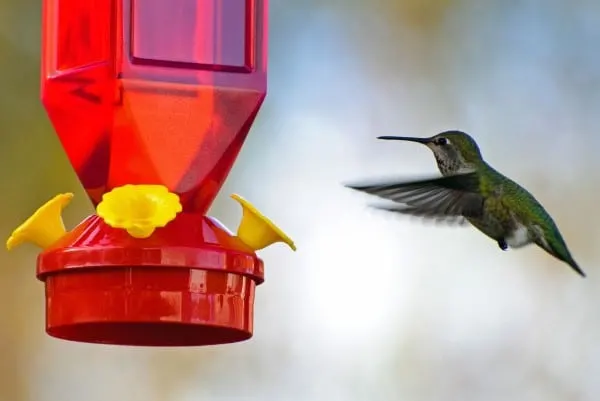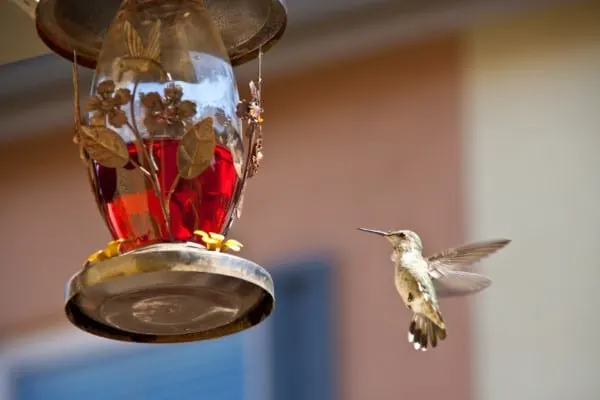Why aren’t hummingbirds coming to my feeders? Have you done everything to the best of your ability to make your yard hummingbird-friendly but are yet to spot a single bird?
Worry not. While attracting these sketchy birds can be a challenge to total beginners, there are a few things you can do to rectify the situation.

Why Aren’t Hummingbirds Coming to My Feeder?
Fresh Food
Since hummingbirds have one of the fastest metabolisms of any bird, it’s normal for them to have several meals a day. Furthermore, they have a sweet tooth, making their primary food source any flower with nectar containing over 10 percent of sugar.
With that in mind, probably one of the main reasons these birds have stopped coming to your feeders is that better food sources exist in your neighborhood. So, if you have the time, plant some of their favorite plants as well besides just putting up feeders.
Note, though, that this doesn’t mean you should neglect your feeders. While the flowery plants will attract the birds, the feeders will make them stay. As such, ensure you’re the nectar in the feeders never goes bad and the feeders themselves are cleaned pretty regularly.
The general rule of thumb is you should change the nectar in your hummingbird feeders every four to six days, when you realize the solution has started to turn cloudy or when its temperature rises above 90 degrees F (approx.. 32 degrees C)
Something else that’s alarming and should be noted every time you’re cleaning your hummingbird feeders is to ensure they do not have mold. Mold is poisonous to hummingbirds and potentially fatal.
With that in mind, if you notice mold growing on the feeders, clean them using a bottle brush and hot water. Do not use any chemicals. Also, rinse the feeders thoroughly and let them dry totally before placing them back.
Territory Protection
Although apparently charming and extremely small in structure, hummingbirds are characterized as some of the wild’s most quarrelsome and aggressive birds.
In an effort to protect their territories, these birds have been known to go as far as dive attacking bigger birds such as blue jays, orioles, and sometimes even hawks.
That said, rarely will a hummingbird attack a huge animal, like a dog or house cat roaming freely in your yard. So, if your cat takes to chasing these birds and hunting them down (as is a cat’s instinctive behavior), the hummingbirds will simply choose to relocate to safer areas without natural predators roaming.
In addition, male hummingbirds are the most territorial and will usually fend off any other males from specific feeders they consider theirs, even if the food there is sufficient to go around.
So, to bypass this issue and bring more birds to your yard, consider placing multiple feeders safe distances from each other instead of one huge feeder.
Better yet, while placing these feeders, ensure they’re positioned in a manner that hummingbirds feeding on one won’t be able to see those feeding on a different feeder. For instance, you could place them at different heights or around corners.

Migration
The fact there aren’t hummingbirds coming to your feeder could have something to do with migration. Hummingbirds are migrant birds, and depending on the species, their migratory patterns differ. There are over 350 known hummingbird species at the moment, with new species getting described each year.
What’s more? A huge portion of the species prefers migrating south (from the north) for the winter, but a good number does stay in the same location all year round.
Regarding what causes these migrations? The short answer is food. As flowers they love go away in their current locations but bloom in other parts of the country, they will migrate.
For instance, each year, ruby-throated hummingbirds migrate from northern Canada to as far as South America or Florida in pursuit of their favorite flowers.
So, if you only notice that hummingbirds aren’t coming to your feeder at a specific period of the year, there is no need to be alarmed. Give them time to exercise their behavioral patterns, and they should return to your yard in the spring.
I’ve come across hundreds of people who tried putting up more feeders in their yards in the fall to dissuade hummingbirds from moving, but it never helps. All one needs is patience.
There Isn’t Sufficient Color In Your Yard to Attract Them
Hummingbirds get attracted to bright colors like orange and red. As such, ensure you have multiple shades of these colors boldly showcasing themselves in your yard. The tricks I use myself include picking and planting lots of orange and red flowers, and only buying red feeders.
Employing these tricks should attract their attention and keep them in your yard for a while.
Ability To Build Their Nests
Hummingbirds prefer building their nests in mini trees and small shrubs. With that in mind, if you do not have anywhere in your neighborhood where they can build their homes, do not expect them to visit you or stay a lot.
Introducing a row of small trees or shrubs could make all the difference in your situation and make the fiery birds feel welcomed.
Too Much Noise
Given they’re tiny creatures, it’s no surprise hummingbirds are wary of loud noises. Barking dogs, children, and loud music have all been proven to scare away the birds. So, if you’d like to create a safe haven for them, try placing the feeders in areas with little to no noise and see how that goes.
Lack of Water
In my previous home, I noticed that hummingbirds visited our backyard more when our sprinklers were on. That’s because these birds love running water. A great addition I recommend to all my readers is a birdbath with a bubbler, and your hummingbirds are sure to appreciate that.
Final Thoughts
I hope the detailed list of reasons why hummingbirds aren’t coming to your feeder has helped you narrow down the issue plaguing your yard. I hope that soon you’ll be able to enjoy the company of these fiery and adorable birds once again.
